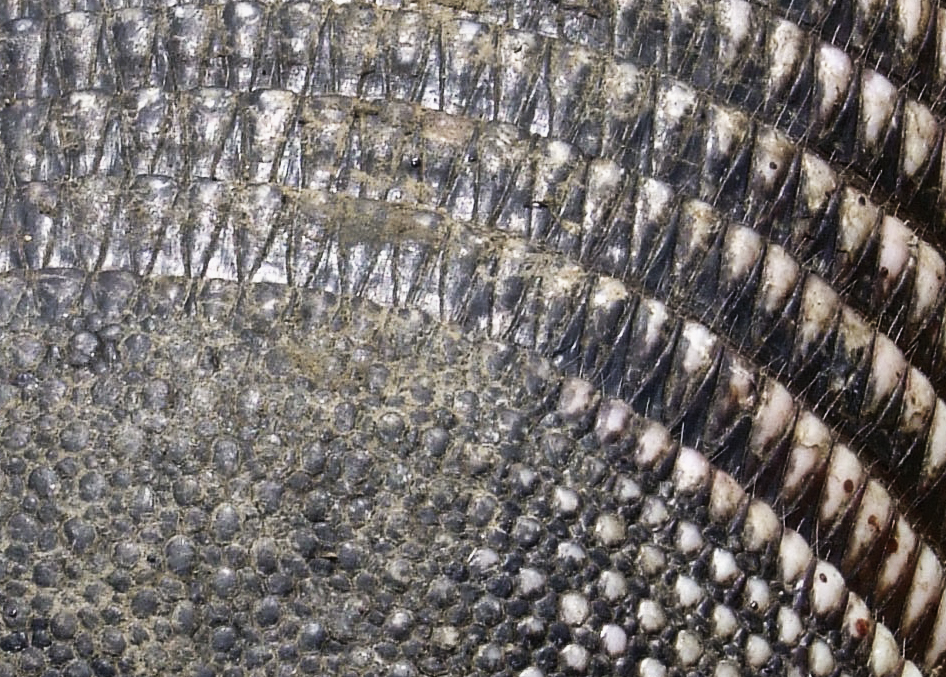Living with Armadillos
Rebecca Spears
 It had to be 98 degrees as I walked the perimeter of my cabin last summer, surveying the damage caused by armadillos. Wow, they had plowed up the entire hill where my cabin sat! They’d sent nearly all the topsoil down to the creek, exposing the underlayers to the heat and drought. No wonder a large crack had developed along the steepest side of the hill.
It had to be 98 degrees as I walked the perimeter of my cabin last summer, surveying the damage caused by armadillos. Wow, they had plowed up the entire hill where my cabin sat! They’d sent nearly all the topsoil down to the creek, exposing the underlayers to the heat and drought. No wonder a large crack had developed along the steepest side of the hill.
A year ago, I’d spent a lot of money for an engineer and an earthworks company to create a stable, level soil foundation for my cabin. In the months after, I’d spread topsoil, then planted grass and liriope on my hill, in an effort to create a natural barrier against soil erosion, crucial to the health of the house’s foundation.
I don’t live at the cabin full-time; I live in a city and commute to my place in the woods about six times a year. So it’s easy for a few armadillos to come in and wreak havoc without humans around full-time. The damage they can do in one night is astounding. Over a few weeks, their work can be monumental. I wanted to scream about the destruction, in fact, and strangle a few armadillos. The only reason I didn’t—I might be fined for throttling an armadillo, because this creature is honored as one of the “state” mammals in Texas.
It’s amazing that I was once fond of armadillos, that just the sight of these “little, armored ones” was amusing, pleasing. Yes, they’re mostly gentle animals, foraging for insects near creeks and ponds. And in this century, they’re a threatened species. What’s the harm in an armadillo? I never thought to ask such a question.
In the middle of my armadillo troubles, Elizabeth Bishop’s poem “The Armadillo” inserted itself into my thinking. Truly, I’m a Bishop fan, and I like to revisit her work every so often. When I reread this poem, I didn’t consciously think it could help, but engaging with poetry is a source of meditation for me.
“The Armadillo” isn’t just about an armadillo, but about “the frail, illegal fire balloons” released during Brazilian celebrations of saints’ days. When the fire balloons “flare and falter, wobble and toss,” they suddenly become dangerous to wildlife, and this is just what Bishop wants us to see when
another big one fell. It splattered like an egg of fire against the cliff behind the house. The flame ran down.
Unfortunately, a pair of “ancient owls,” whose nest “must have burned,” fly “up / and up,” their undersides “stained bright pink” by the fire just below them. The armadillo of the poem “glistens” and is “rose-flecked by the fire,” leaving with its “head down, tail down”; its armor can’t protect it from the fire’s danger. The poet then shows us a small rabbit, “so soft!” but its softness turns grotesque “like a handful of intangible ash.” Here are the vulnerable animals whose lives will be cut short by humans sending up fire balloons meant to celebrate a holy day.
While Bishop’s poem is ostensibly about the specific incident described, the dedication to her friend, the poet Robert Lowell indicates a larger purpose. Lowell, a conscientious objector during World War II, protested US firebombings of cities. In Bishop’s poem, the balloons that bring fire to the wildlife echo on a small scale what it might’ve been like to live in a firebombed city:
Too pretty, dreamlike mimicry! O falling fire and piercing cry and panic, and a weak mailed fist clenched ignorant against the sky!
The “weak mailed fist” suggests the soldier, who even though well armored like the armadillo, cannot win in a conflagration.
For readers today, getting at Bishop’s intention requires some digging. Yet her poem resonates for me in the way we humans have encroached into the natural world. In situating my own cabin, I know I’ve disturbed the wildlife, from fire ants to armadillos to coyotes. No, I didn’t wish to destroy the natural scenery, or animal habitats; and I do understand how much of the natural world we’ve already gobbled up. I’m aware that the East Texas woods now receive a lot less rain than they did in decades past. Just two years ago, wildfires threatened the areas close to my new habitat. There, and in “The Armadillo,” I’m reminded that we share the God-given world.
When I felt the urge to destroy armadillos after they destroyed my hillside, I scared myself. After all, these guys only did what armadillos naturally do. I don’t think I can return to my old fondness for armadillos, but I want to find a way to handle them without animosity—a fence maybe.